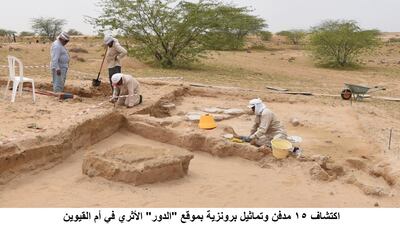More than a dozen tombs, artefacts and jewellery dating back to the first century have been excavated in Umm Al Quwain.
At Ed-Dur, one of the largest archaeological sites in the UAE, 15 tombs, settlement remains, bronze statuettes, pottery and jewellery were uncovered, according to emirate's Department of Tourism and Antiquities.
Alia Al Ghafli, director general of the department, said coins, in a style derived from those of the 4th Century BC Greek emperor Alexander the Great, were also found.
Also known as ‘Arabian Alexanders’, such coins were widely circulated in the eastern Arabian peninsula around the beginning of the Christian era. The discovery, several years ago, of a stone mould used for making coins, at Mleiha, Sharjah, confirmed that some of the coins was minted in the UAE, reported state news agency Wam.
Ed-Dur lies along the south-east coast of the Arabian Gulf and overlooks the shallow lake of Khor Al Beidha. It is surrounded by high sand dunes, which protect it from the northern offshore wind that prevails in the region.
Excavation began at Ed-Dur - which translates from Arabic to 'the houses' - in the 1970s. The site was discovered by an Iraqi archaeologist in 1973 and excavation began a year later, uncovering the remains of stone houses and coins.
Between 1989 and 1995, further excavations found the solar deity temple, which was decorated with Aramaic inscriptions.
In 2015, more than 500 tombs dating back 2,000 years were discovered. The tombs were found near the ruins of stone houses and a temple, and other items including pre-Islamic religious relics, weapons, jewellery and pottery.
The graves – which were made of stones from the sea and were rectangular in shape – revealed much about the lives of the inhabitants of the region in those times.
“The direction of all tombs is north-east, except one is north-west, and all of them were built beside the houses because they believed that life and life after death are one and indivisible,” Ms Ghafli said at the time.

